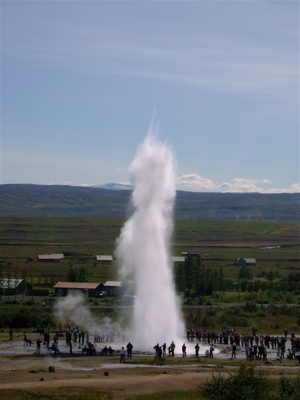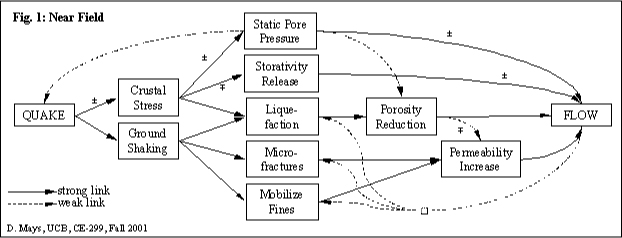

Left) Strokkur geyser -- erupts every 3-4 minutes (at least during my visit during the 2008 IAVCEI meeting). Right) Strokkur (right) and the Great Geysir (left). Geysers get their name from this geyser -- Geysir erupts about twice/day.
In this course we will learn how and why geysers and mud volcanoes erupt. Of particular interest will be trying to understand how and why they respond to the small dynamic strains generated by distant earthquakes. Such understanding should provide new insights not only into geyser and mud volcano eruptions, but also into earthquake triggering processes more generally.
We will discuss the hypotheses that have been advanced to explain observations. No textbook is required, however, as a reference we will follow Ingebritsen et al. (Groundwater and Geological Processes, CUP) and Wang and Manga (Earthquakes and Water, Springer) for the background material; original papers will be assigned for reading and discussion. The book Earthquakes and Water grew out of a previous version of this class.
There will be one group project in which we will monitor the eruption of a geyser, and possibly a mud volcano. We will use the widest range of instrumentation possible, including hopefully a tiltmeter, self-potential, temperature, an infrared camera, and a seismometer. Each participant will be responsible for one of these measurements. Shaul Hurwitz at the USGS will participate in the field project (and he, with USGS colleagues, have done similar measurements before). Other possible projects (or alternative group projects) include lab experiments on the hydrofracturing of unconsolidated materials, or developing numerical models of geysers and mud volcanoes.
The course will begin with a condensed overview of hydrogeology and the coupling of fluid flow with rock deformation. In the remaining weeks we will read and discuss papers and ideas. The outline below is a starting point that will be updated weekly. Each participant will also lead or co-lead two of these weekly discussions. Everyone else will read at least a subset of these papers -- the most relevant ones -- to be determined once we finalize a reading list.
Note for leading discussions: When reviewing and presenting papers please begin by stating the question(s) the paper is(are) trying to answer. Is there a controversy? Is there a new observation that the authors are trying to understand? What makes the problem interesting? Next explain what they did (ideally highlighting what is new). No need to explain all the math, methods or figures, but it is good to explain when and where critical assumptions and approximations are being made. Then, summarize the results focussing only on what you think is interesting or what matters (lots of papers have lots of extraneous content that is included for completeness). Next, summarize what they learned and whether the question was answered. End with your thoughts on what is needed to make further progress or a critism of the work.
Instructors: Chi Wang and Michael Manga (office hours M-W-F 10-noon)
First meeting: January 20 (Wednesday), 1:00 pm
Room: McCone 401 (on the balcony)
A preliminary syllabus (with readings to be updated weekly):
- Week 1 (January 20): Introduction to earthquake hydrology, goals and course overview
- Wang, C.-Y. and M. Manga (2010) Earthquake Hydrology, Springer, chapter 1. online version
- Week 2 (January 27): Introduction to hydrogeology and Darcy's equation
- Ingebritsen, S.E. et al. (2006) Groundwater in geologic processes, Cambridge Univ Press, chapter 1.
- Wang, C.-Y. and M. Manga (2010) Earthquake hydrology, Springer, Appendices B and C. online version
- Forster, C. and L. Smith (1989) The influence of groundwater flow on thermal regimes in mountainous terrain: a model study, J. Geophys. Res., 97, 9439-9451.
-
Week 3 (February 3) Introduction to poroelasticity and coupling with fluid flow
Reference
- Wang, H. (2000) Linear poroelasticity, Princeton Univ Press
- Ingebritsen, S.E. et al. (2006) Groundwater in geologic processes, Cambridge Univ Press, chapter 2.
- Wang, C.-Y. and M. Manga (2010) Earthquake hydrology, Springer, Appendix D. online version
Reading
- Cocco, M., and J.R. Rice (2002) Pore pressure and poroelasticity effects in Coulomb stress analysis of earthquake interactions, J. Geophys. Res., 107, doi:10.1029/2000JB000138.
- David, C. et al. (1994) Laboratory measurements of compaction-induced permeability change in porous rocks: Implications for the generation and maintenance of pore pressure excess in the crust, PAGEOPH, 143, 425-456.
- Week 4 (February 10) Introduction to geysers (Max)
- Lu, X. and S.W. Kieffer (2009) Thermodynamics and mass transport in multicomponent, multiphase H2O systems of planetary interest, Annual Reviews of Earth Planet. Sci., 37, 449-477. pdf
- Ingebritsen, S.E., Rojstaczer, S.A. (1993) Controls on geyser periodicity. Science, 262, 889-892. pdf
- Ingebritsen, S.E., and S.A. Rojstaczer (1996) Geyser periodicity and the response of geysers to small strains in the Earth. J. Geophys. Res., 101, 21,891-21,907. pdf
- Kieffer, S.W. (1989) Geologic nozzles. Reviews of Geophysics, 27, 3-38. pdf
- Rinehart, J. (1980) Geysers and Geothermal energy
- Week 5 (February 17) Introduction to mud volcanoes (Jennifer)
- Kopf, A.J. (2006) Significance of mud volcanism. Reviews of Geophysics, 40, 1005. pdf
- Mazzini, A. (2009) Mud volcanism: Processes and implications. Marine and Petroleum Geology, 26, 1677-1680. pdf
- Week 6 (February 24) Geysers, general features (Ben, Nick)
- Silver, P.G., and N.Y. Valette-Silver (1992) Detection of hydrothermal precursors to large northern California earthquakes. Science, 257, 1363-1368. pdf
- Rojstaczer, S., Galloway, D.L., Ingebritsen, S.E., and D.M. Rubin (2003) Variability in geyser eruptive timing and its causes: Yellowstone National Park, Geophys. Res. Lett., 30, article number 1953. pdf
- Husen, S., Taylor, R., Smith, R.B., and H. Healser (2004) Changes in geyser eruption behavior and remotely triggered seismicity in Yellowstone National Park produced by the 2002 M 7.9 Denali fault earthquake, Alaska. Geology, 32, 537-540. link to paper
- Lu, X., Watson, A., Gorin, A.V., Deans, J. (2005) Measurements in a low temperature CO2-driven geysering well, viewed in relation to natural geysers. Geothermics, 34, 389-410. pdf
- Week 7 (March 3) Liquefaction (Ian, Chi)
- For everyone: Chapter 2 on liquefaction in Wang, C.-Y. and M. Manga (2010) Earthquake Hydrology, Springer. online version
- Holzer et al. (1989) Dynamics of liquefaction during the 1987 Superstition Hills, California, earthquake, Science, 244, 56-59.
- Baise, L., S.D. Glaser, D. Dreger (2003) Site response at Treasure and Yerba Buena Islands, California. J. Geotech. Geoenviron. Eng., ASCE, 415-426
- Wang et al. (2006) Liquefaction limit during earthquakes and underground explosions: Implications for ground-motion attenuation, BSSA, 98, 355-363.
- Dobry, R. (1989) Some basic aspects of soil liquefaction during earthquakes, Ann. New York Acad. Sci., 558, 172-182.
- Week 8 (March 10) Geyser models (Leif, Adam)
- Steinberg, G.S., Merzhanov, G.S., and Steinberg, A.S. (1982) Geyser process: Theory, modeling, field experiment. Part 1.Theory of the geyser process, Modern Geology, 8, 67-70.
- Steinberg, G.S., Merzhanov, G.S., Steinberg, A.S. and Rasina, A.A. (1982) Geyser process: Theory, modeling, field experiment. Part 2. A laboratory model of a geyser, Modern Geology, 8, 71-74.
- Steinberg, G.S., Merzhanov, G.S., and Steinberg, A.S. (1982) Geyser process: Theory, modeling, field experiment. Part 3. On metastability of water in geysers, Modern Geology, 8, 75-78.
- Steinberg, G.S., Merzhanov, G.S., and Steinberg, A.S. (1982) Geyser process: Theory, modeling, field experiment. Part 4. On seismic influence on geyser regime, Modern Geology, 8, 79-86.
- Merzhanov, G.S., Steinberg, A.S, and Steinberg, G.S., Heat and mass exchange in geyser systems, 323-328.
- Shteinberg, A.S. (1999) An experimental study of geyser eruption periodicity, Power engineering, 366, 47-50.
- Week 9 (March 17) Changes in permeability caused by earthquakes (Pascal, Chi)
- Elkhoury, J.E., Brodsky, E.E. and D. Agnew (2006) Seismic waves increase permeability, Nature, 441, 1135-1138. paper
- Elkhoury, J.E. (2010) J. Geophys. Res., in review. pdf
- Section 3.2 in Manga, M. and C.-Y. Wang (2007) Earthquake Hydrology, Treatise of Geophysics. pdf
- Muir-Wood, R., and G.C.P. King (1993) Hydrological signatures of earthquake strain. J. Geophys. Res., 98, 22,035-22,068. pdf
- Rojstaczer, S., Wolf, S., and R. Michel (1995) Permeability enhancement in the shallow crust as a cause of earthquake-induced hydrological changes. Nature, 373, 237-239. paper
- Manga, M., Brodsky, E.E., Boone, M. (2003) Response of streamflow to multiple earthquakes and implications for the origin of postseismic discharge changes. Geophys. Res. Lett., 30, doi:10.1029/2002GL016618. pdf
- Wang, C.-Y., Wang, C.-H., and M. Manga (2004) Coseismic release of water from mountains: Evidence from the 1999 (Mw = 7.5) Chi-Chi, Taiwan, earthquake. Geology, 32, 769-772. pdf
- Week 10 (March 31) The LUSI mud volcano eruption. 1. Earthquake trigger? (Michael, Zack, Rebecca)
- Mazzini, A. et al. (2007) Triggering and dynamic evolution of the LUSI mud volcano, Indonesia. Earth and Planetary Science Letters, 261, 375-388. pdf
- Manga, M. (2007) Did an earthquake trigger the May 2006 eruption of the Lusi mud volcano? EOS, 88, 201. pdf
- Davies, R.J. et al. (2008) The east Java mud volcano (2006-present): An earthquake or drilling trigger? Earth and Planetary Science Letters, 272, 627-638. pdf
- Sawolo, N. et al. (2009) The LUSI mud volcano triggering controversy: Was it caused by drilling? Marine Petroleum Geology, 26, 1766-1784. pdf
- Manga et al. (2009) Earthquake triggering of mud volcanoes, Marine Petroleum Geology, 26, 1785-1798. pdf
- Davies et al. (2010) Comment on Sawolo et al. (2009) paper, Marine Petroleum Geology, in press and the Sawolo et al. reply. pdf
- Week 11 (April 7) The LUSI mud volcano eruption. 2. When will it end? (Michael, Zack, Rebecca)
- Istadi, B.P. et al. (2009) Modeling stdy of growth and potential geohazard for LUSI mud volcano: East Java, Indonesia. Marine Petroleum Geology, 26, 1724-1739. pdf
- Swarbrick et al. (2009) AGU presentation.
- Zoporowski, A., and S.A. Miller (2009) Modelling eruption cycles and decay of mud volcanoes, Marine Petroleum Geology, 26, 1879-1887. pdf
- Week 12 (April 14) Triggered seismicity (Amanda, Chi)
- John Vidale's Gutenberg Lecture "Tremor, the Curious Third Wheel of Fault Motion", view talk
- Thomas, A., R. Nadeau and R. Burgmann (2009) Tremor-tide correlations and near-lithostatic pore pressure on the deep San Andreas fault, Nature, 462, 1048-1051. download from Nature
- Shelly, D.R. (2010) Migrating tremors illuminate complex deformation beneath the seismogenic San Andreas fault, Nature, 432, 648-652. download from Nature
- Peng, Z., and K. Chao (2008) Non-volcanic tremor beneath the Central Range in Taiwan triggered by the 2001 Mw7.8 Kunlun earthquake, Geophys. J. Int., 175, 825-829, doi: 10.1111/j.1365-246X.2008.03886.x.
- Week TBD Mud volcanoes on Mars (Edwin)
- Skinner Jr, J.A. and A. Mazzini (2009) Martian mud volcanism: Terrestrial analogs and implications for formational scenarios. Marine and Petroleum Geology, 26, 1866-1878.
- Skinner Jr, J.A. and K.L. Tanaka (2007) Evidence for and implications of sedimentary diapirism and mud volcanism in the southern Utopia highland-lowland boundary plain, Mars, Icarus, 186, 41-59.
- Field project
- April 21: Install seismometers and tiltmeters
- April 28: Everything else
Slides from the first lecture INCLUDING draft schedule and assignments
Reading
References
Reading
Reading
References
Reading
Reading
Reading
The papers below are supplemental, and are briefly discussed in the liquefaction chapter
Reading (note: these papers will be left in a box in McCone 307; read at the very least the paper in Power Engineering)
Reading
Reading
Reading
Reading
Reading
Two dates
Many of these papers are in a box labeled EPS 200 in room 307. Please copy them and RETURN the originals to the box.
David Mays prepared the following figure illustrating the various relationships between hydrological processes and earthquakes

Return to Michael's home page